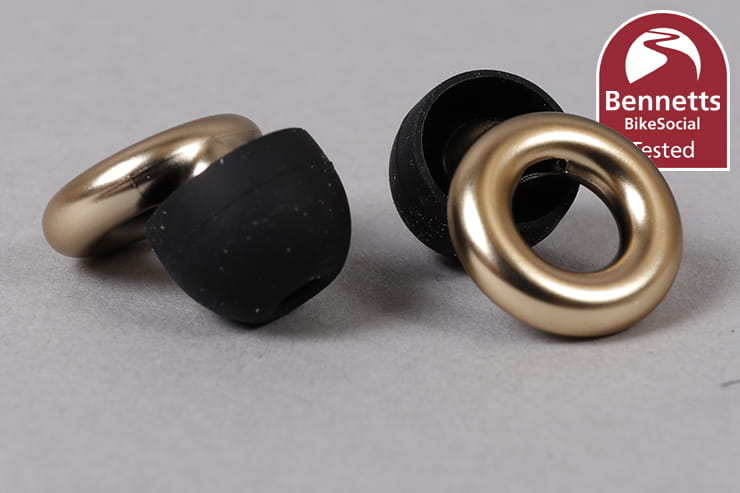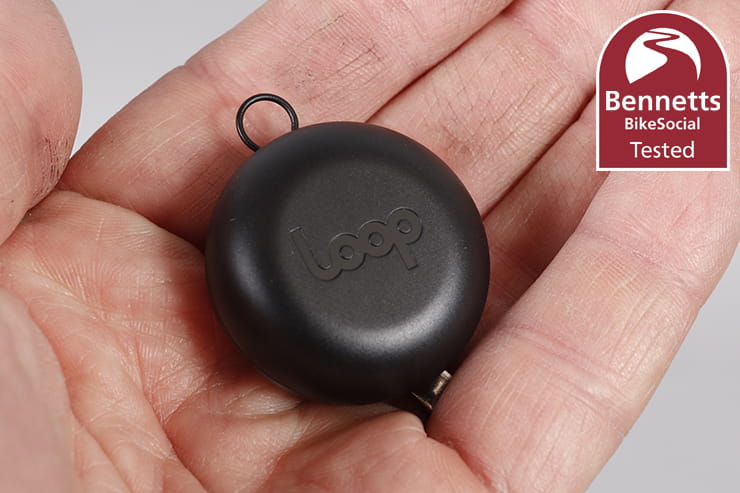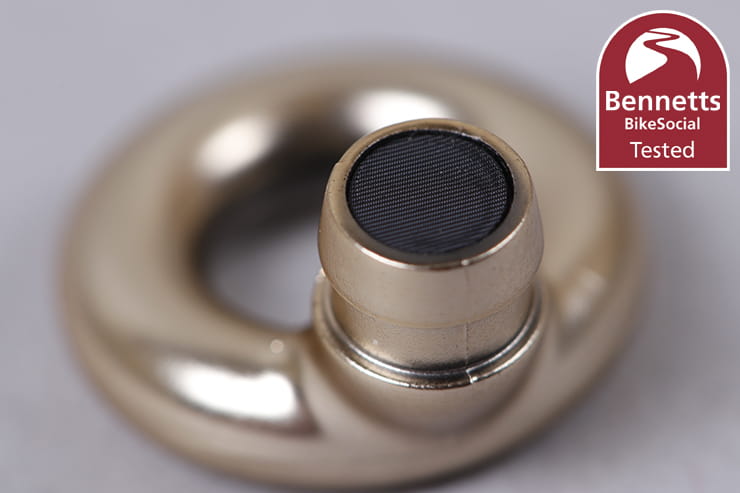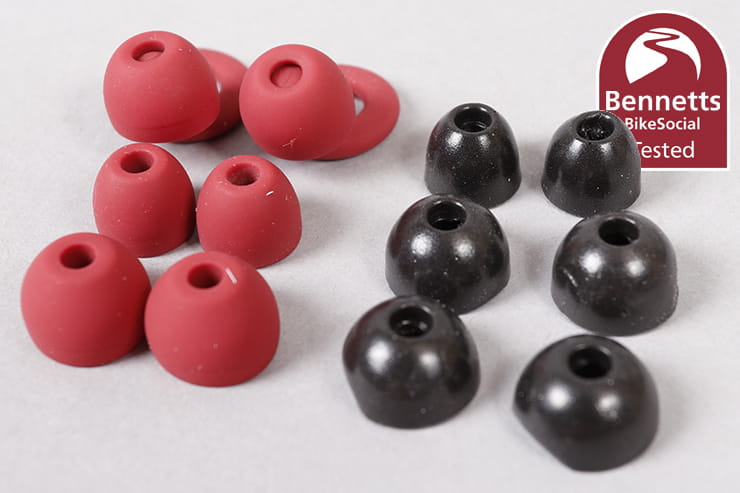We’ve tested the Loop Experience and Loop Quiet earplugs
Date reviewed: January 2021 | Tested by: Bennetts Rewards members Patricia Stiemke & Jon Ashley | Price: £23 (Experience), £14 (Quiet) | eu.loopearplugs.com
The Loop earplugs on review here are available in three versions – the £14 ‘Quiet’ and £23 ‘Experience’ on test, as well as the new ‘Experience Pro’, which promises slightly increased attenuation for £32.
Patricia Stiemke is a Bennetts Rewards member and has tested both the Quiet and the Experience earplugs while wearing an HJC RPHA11 and an AGV K7 on her 2019 Honda CBR500R for more than 1,500 miles on a wide variety of roads…
For and against
- Good balance of wind noise reduction and ability to hear speech properly
- Selection of foam and silicone ear tips in three sizes
- Too big to fall down sink drain holes.
- Experience model not suitable for windy days
- If not sitting properly, prone to distracting sound artifacts
- Carrying pouch for the Quiet model not hygienic or suitable for a keyring.
Why should you wear earplugs on a motorcycle?
Although there seem to be many reasons to tune out the world these days, there are still more arguments for keeping your hearing in a decent state than against. It’s therefore vital to wear hearing protection when sitting on top of a combustion engine going along at more than walking speed. Even those fortunate enough to enjoy the quiet of electric motorcycles are not immune to wind and road noise, which will damage your hearing over time. The science behind these assertions has been covered in this excellent BikeSocial article.
I start becoming rather jittery and nervous – especially at higher speeds – if I’ve forgotten to plug my ears, and am easily distracted by anything adding to the cacophony. Even if an earplug slips out of position during my ride, I’ll take the time to pull over and re-adjust as I find the noise so uncomfortable.

The Loop Experience has a filter built in to allow some frequencies through more easily, while the Loop Quiet is just solid silicone
Construction and ease of use
The Loop earplugs consist of an outer cylindrical smooth plastic (Experience) or soft, pliable silicone (Quiet) loop, with the Experience model containing an acoustic channel on the inside of that loop. The Quiets are one-piece, solid silicone, which is why they block more sound.
A widening shaft with a filter at the end (only on the Experience) sits in the ear canal, covered by a choice of ether foam or silicone tips in three supplied sizes; small, medium and large. The foam tips feel quite solid, but tend to slip out of my ears so are not for me. The silicone tips are easy to fit into place to form a firm seal.
Given the plastic feel of the Experience I was surprised how smooth and unobtrusive it felt nestling against the Tragus of the ear (the little semi-circular thick flap next to the cheekbone) and all the other soft ridges; I forgot about them rather quickly. The softer Quiet Loops are more pliable due to being made of silicone and are completely unnoticeable after being inserted; the only thing you feel is the tips in the ear canals.
The insertion process is the usual pull back a bit on the middle of the ear lobe, insert and rotate the loop until the plug tip sits comfortably in your canal and forms a seal. The big plus here is that the loops on the, ermm, Loops prevent you from pushing the tips too far into the ears. For someone who’s had to use tweezers once or twice in the past to pull out other earplugs, this is a real bonus.
Despite expectations, my helmet doesn’t interfere with, or dislodge the Loops.
For storage, the package comes with a tiny snap-lock case for the Experience which, in my opinion, is a bit too small as it won’t close unless the plugs are positioned just so.
The Quiet plugs come with a bigger faux-leather zip pouch with an inner cloth lining. I don’t see how you can keep this clean over the long term and I’m not using it. It also isn’t designed to fit on a keyring.
The Experience Case is nicer than the one supplied with the Quiets, but the little tether for a keyring isn’t particularly tough
Performance: Loop Experience earplugs
Besides liking the build and the interesting look once they sit in the ear, I am, on the whole, quite pleased with the performance of the Quiet Loop plugs, but not so much with the Experience model.
The Experience comes with noise reduction data on and in the package, claiming a reduction of 20dB. The filters have a mean Single Number Rating (SNR) of 18. SNR is the standard used in Europe for measuring noise level reduction in decibels. Looking at the figures quoted across the frequency ranges, an SNR of 17 covers the 125Hz range, it’s 15.7 for 250 Hz, 14.3 for 500Hz and 19 for the 1,000Hz frequency ranges. Anything above that is not really relevant for motorcyclists but the Experience offers quite decent attenuation for the high frequencies, which would be appropriate if you have kids at home learning the violin and practicing a lot on the E-string!

Silicone and foam tips are supplied
As for practical noise reduction on the bike at speed, the Experience works fine until the winds pick up. Overall, the high-pitched wind noises – the sound I’m most sensitive to – are quite well mitigated, even at speeds above 70mph, and up to about 40 I can’t hear the wind at all. What I do hear is the growl of the engine, though not at an annoying level and I’m able to monitor how the bike’s running. This pretty accurately reflects the SNR numbers given for the low and high ranges.
There is another sound though, which some may find distracting – you hear a faint echo of the rushing wind. It’s like a gentle swishing in your ears and I find it quite soothing. However, others may react differently.
These plugs will allow you to carry on a conversation at an almost normal level without inadvertently raising your own voice. The music I listen to through my Sena SMH5 is also very easy to hear at the low volume the speakers provide, and delivers a decent midrange sound. Also, emergency vehicles are definitely audible.
The big caveat though is if the prevailing wind conditions increase, while still sufficiently mitigating the higher frequencies, if the prevailing winds are forecast at anything over about 25mph, the lower range of the wind noises really buffet the ears, even drowning out the engine noise. It’s just too loud.
Here you can see the small opening in the Loop Experience, which allows sound up to the filter
Performance: Loop Quiet earplugs
The Quiet Loop model is a different story. It offers no SNR data in the package or on the website, but it does claim a 30dB noise reduction and is marketed at people trying to get a good night’s sleep thanks to the all-silicone construction; I wouldn’t relish lying on my ear with the plastic Loop Experience pressing against it.
You don’t have the howling noise in your ear on windy days with these plugs, but the growling of the engine is also less noticeable. Emergency sirens are just as audible but you do have to step a bit closer to people wanting to talk to you. Music quality through an intercom is almost as good as the Experience, although some of the mid-range goes missing at higher speeds. Considering the other performance advantages though, I can live with that.
One issue to be aware of for both models is that if they haven’t formed a proper seal in your ear canal, you may perceive surrounding loud cars or other machinery as strange sound artifacts in your ear. A noisy car can sound like someone using a chainsaw at a distance for example. It’s not loud but can be disturbing if it takes you by surprise.
Various colours are available in both models – here you can see two alternatives for the Quiet, though the foam tips are always black
Loop earplugs compared to others
My ear plug collection has grown over time and I think I can safely say that in terms of balancing the need to hear emergency vehicles, engine sound, conversation and in-helmet music with the essential mitigation of damaging levels of engine and wind noise, these offer the best experience so far. The Quiet Loops work just that little bit better on all levels than the Ear Peace plugs I’ve written about previously.
In terms of absolute riding noise reduction, no earplug can cut out as much noise as something like the disposable 3M EAR Soft FX, but they come at the cost of not being able to hear music, speech or engine sound anywhere near as well. I don’t feel comfortable riding in near silence – it feels like I’m a bit too far removed from my surroundings.
The one comparison that’s always a bit difficult is with custom plugs; I had a pair but they stopped working over time; I was told that my ear canal had changed shape and was kindly provided with a free newly-fitted pair, but even they became less effective after six months, particularly in one ear. I’ve given up on them now, especially as they’re also by far the most expensive option, particuarly if you lose them. However, I have known people who swear by them and have had the same pair for ages.

Loop Experience / Quiet earplugs review: Patricia’s verdict
Having tested a wide variety of earplugs I would suggest that the Loop Quiet earplugs are the next best thing to moulded plugs, but they don’t stop working when your ear canal changes shape. They won’t break the bank for that matter, either.
The Loop Experience generate a bit too much low-range howling wind noise on breezy days for my liking, but the Loop Quiet really are a good choice if, like me, you don’t mind the low growl of your engine being audible. I’ve got used to it and it’s more comforting than annoying.
The Quiet plugs are very comfortable and have that funky look that makes it appear like an ear adornment rather than just a functional earplug.
I know that hearing protection, like eyewear is down to personal needs and preferences so it’s not really possible to make recommendations for everyone, but at £14 for the Loop Quiet, I’d definitely recommend giving them a try. I’ve now put away all previous plugs and have adopted the Loop Quiet as my current favourites.
Loop Experience / Quiet earplugs review: Jon Ashley’s verdict
As we also gave a set of Loop Experience and Quiet earplugs to Bennetts Rewards member Jon Ashley, he had a chance to try them in his Arai RX7-SV…
“I’ve used a wide range of earplugs over the years, from the mushroom types with baffles built in (Alpine, Pinlock), to foam plugs and specialised units by Flare Audio.”

Left to right: ACS musician ear plugs (old model), Free Ear Plugs issued to audience at My Bloody Valentine gig (2007), Alpine MusicSafe, Pinlock Earplugs, Oxford Ear Plugs SNR39, Flare Audio Isolate Aluminium
“The Loop units can be fiddly to insert into my ears, but they sit close and are quite unobtrusive. With any ear protection, the key is to ensure the right size adapter is used; too small and it’ll fall out, too big and it can sit incorrectly and return the same result. Still, all humans are different and that applies to your ear and ear canal, so any fitment is always a compromise. The Loop plugs have a silicone earbud option or a squashable foam-based bud, so you can experiment with the S/M/L sizes in both textures, but the foam options tended to pop out of my ears.
“Between the two versions, I preferred the ‘Quiet’ version, as I found them easier to tuck into my ears and were the most comfortable.
“I don’t get any ‘device-noise’ with the Loops, which can occur if the inside of your helmet lining interacts with the outside of the earplug, sending rumbles or movement noises into your ear. The Alpine and Flare Audio plugs I have, which protrude more, can suffer from this.
“When riding, the Loop earplugs do block out a range of frequencies; you can still hear the engine, but wind noise is reduced and there’s that slightly more peaceful muting. This matches the performance of the Pinlock plugs in my view.
“The Loops are well worth trying as they’re at least equalling the others I’ve used over the years. A very innovative design, at a reasonable price with good build quality.”

Loop Experience / Quiet earplugs review: Bennetts BikeSocial’s verdict
Patricia and Jon have done an excellent job of covering everything in this Loop earplugs review, but I thought I’d add my experience…
As Jon points out, if an earplug rubs on the lining of your helmet, it can create a very annoying noise inside; for me this was an issue, especially on the more expensive Experience earplugs. This proves the point that we do all have different shaped heads and ears, so recommending a product like this can be hard.
The Quiet earplugs are my preferred choice between the two, but as they have no filter and come with a very cheap case they’re rather costly for what they are. Still, the design is clever and does make them easy to remove.
Personally, I listen to music through an intercom and have no problem hearing other traffic while wearing the disposable 3M EAR Soft FX plugs. As these can be used for a good while before needing replacing, and work out at less than 17p each if bought as a box of 200, it’s hard not to find them appealing.
I’ve also tried different custom-fit earplugs and simply don’t get on with them but the Pinlock earplugs or the similar Auritech Bike strike a very good balance of price and performance at about £20, while offering a built-in filter that, like the Loop Experience, allow you to hear more of other people speaking, as well as working better with intercom systems. In the case of these earplugs though, they have a higher SNR and better attenuation across the frequency range, offering increased hearing protection that’s more suited to riding bikes, rather than the Loop Experience that, as the name suggests, are more designed for experiencing music concerts and the like.
For me though, the Ear Peace earplugs would be my recommendation, thanks to the fact that they include a spare earplug and a decent-quality metal tube case, along with a choice of filters. John Milbank, Consumer Editor


















